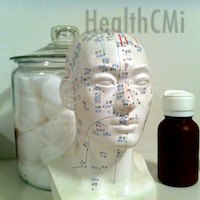New research proves that acupuncture combined with neuromuscular electrical stimulation (NMES) is effective for restoring hand function in hemiplegic patients. Researchers measured significant improvements in both wrist and finger functionality. Hemiplegia is paralysis of one side of the body caused by disease or injury to the brain’s motor centers. Hemiplegia may be caused by an illness, injury, stroke or may be congenital.  This study, conducted at the Affiliated Hospital of Chengdu University (Sichuan), documents two specific acupuncture protocols that achieved significant positive patient outcomes in the restoration of hand motor activities including holding, grasping, moving and pinching.
This study, conducted at the Affiliated Hospital of Chengdu University (Sichuan), documents two specific acupuncture protocols that achieved significant positive patient outcomes in the restoration of hand motor activities including holding, grasping, moving and pinching.
Treatment group #1 received acupuncture combined with moxibustion. Treatment group #2 received the same acupuncture and moxibustion therapy plus the addition of NMES. Both groups demonstrated significant positive patient outcomes, however, group #2 demonstrated clinically superior outcomes.
The basic care given to both groups consisted of standard body style acupuncture, scalp acupuncture and moxibustion. Standard acupuncture was applied to patients with 1-1.5” filiform acupuncture needles applied to the hand and foot yangming channels on the hemiplegic side. Secondary acupuncture needling was applied to the taiyang and shaoyang channels. Additional points were added to the upper limb of the hemiplegic side:
Jianyu (LI15)
Jianqian (EX-UE)
Quchi (LI11)
Shousanli (LI10)
Waiguan (SJ5)
Yangchi (SJ4)
Yangxi (LI5)
Yanggu (SI5)
Hegu (LI4)
Manual acupuncture needle stimulation was applied along the channels with an even reinforcing-reducing method. After the arrival of the deqi sensation, strong stimulation was applied to:
Quchi (LI11)
Waiguan (SJ5)
Yangxi (LI5)
Yangchi (SJ4)
Yanggu (SI5)
Hegu (LI4)
The retention of needling was 20-30 minutes. Acupuncture was applied once daily with 10 days comprising one course.
During scalp acupuncture, the acupuncturist used 1” disposable filiform needles. The motor cortex are was needled with a quick insertion technique at a 30 degree angle. Quick twirling at a rate of approximately 200 times per minute was applied for one minute. Five minutes of needle insertion time followed the quick twirling time. Next, another one minute of quick twirling was applied. Scalp acupuncture sessions lasted for 20 minutes each acupuncture treatment. One acupuncture treatment was applied each day and 10 days comprised one course of care.
Moxibustion was applied with both the suspended moxibustion and bird pecking moxibustion techniques to the following acupuncture points:
Jianyu (LI15)
Quchi (LI11)
Waiguan (SJ5)
Yangxi (LI5)
Yangchi (SJ4)
Hegu (LI4)
Moxibustion was applied for three minutes at each acupoint. Additional moxibustion was applied to the affected side at:
Yanglingquan (GB34)
Zusanli (ST36)
Qihai (RN6)
Guanyuan (RN4)
Shengque (RN8)
The moxibustion was applied for five minutes at each acupuncture point for 24-25 minutes. Moxa was applied one time per day and 10 days comprised one course of care. 
Group #2 received the aforementioned care plus the following low frequency neuromuscular electrical stimulation (NMES). Stimulation parameters were set to a square wave and exponential wave with an initial 4 Hz frequency and then a setting of 0.5-100Hz. Two electrodes were connected to the posterior aspect of the wrist on the affected side. The intermittent stimulation cycle was set to 10-12 seconds of continuous stimulation followed by a pause time of 2-4 seconds. Each treatment was 20 minutes and were applied once daily, five times per week and 10 times comprised one course of care.
Three courses of care were applied to all patients in both groups for all treatment modalities. Group #1 and group #2 demonstrated significant improvements in hand function, however, group #2 demonstrated clinically superior patient outcomes. The researchers conclude that acupuncture combined with NMES greatly improves wrist and finger functions for patients with hemiplegia.
Reference:
Zhang, Haiyan. “Clinical observation on acupuncture combined with neuromuscular electrical stimulation’ restoring hemiplegic patients’ hand functions.” Modern Journal of Integrated Traditional Chinese and Western Medicine 23.14 (2014): 1510-1511.


